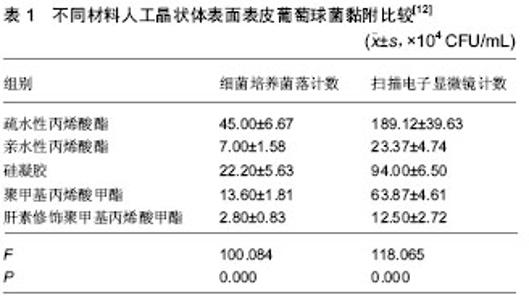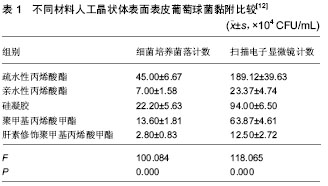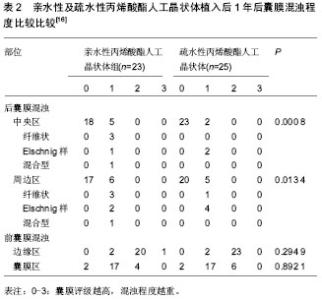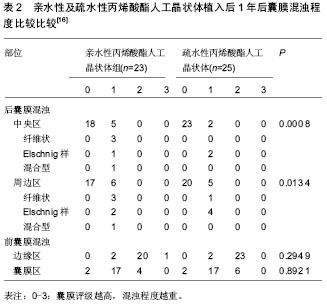| [2] Mukherjee R, Chaudhury K, Das S, et al.Posterior capsular opacification and intraocular lens surface micro-roughness characteristics: an atomic force microscopy study.Micron. 2012; 43(9):937-947.
[3] 罗怡,陆国生,卢奕.亲水性丙烯酸酯人工晶体混浊临床报告[J].中国实用眼科杂志,2003,21(7):530.
[4] 李世宏,叶剑,郑灿,等.亲水性丙烯酸酯人工晶体植入后前囊膜挛缩1例[J].第三军医大学学报,2007,29(24):2306.
[5] 邓锐东, 陈子林.亲水性丙烯酸酯人工晶体混浊1例[J].汕头大学医学院学报,2012,25(4): 封3
[6] 曹向荣,龚力力,杨漪,等.超声乳化白内障吸除术后眼内炎的临床分析[J].中华眼科杂志,2005,41(6):519-522.
[7] 李华.超声乳化白内障吸除术后眼内炎的临床特点探析[J].中国实用医药,2013,8(31):100-101.
[8] 陈惠英,徐学东.白内障摘除联合人工晶状体植入术后感染性眼内炎临床观察[J].南通医学院学报,2009,29(5):380-381.
[9] Baillif S, Ecochard R, Casoli E,et al.Adherence and kinetics of biofilm formation of Staphylococcus epidermidis to different types of intraocular lenses under dynamic flow conditions.J Cataract Refract Surg. 2008;34(1):153-158.
[10] Fazly Bazzaz BS, Jalalzadeh M, Sanati M, et al.Biofilm Formation by Staphylococcus epidermidis on Foldable and Rigid Intraocular Lenses.Jundishapur J Microbiol.2014; 7(5): e10020.
[11] Sadaka A, Durand ML, Gilmore MS.Bacterial endophthalmitis in the age of outpatient intravitreal therapies and cataract surgeries: host-microbe interactions in intraocular infection. Prog Retin Eye Res. 2012; 31(4):316-331
[12] 范小娥,田芳,李筱荣.不同材料人工晶状体表面表皮葡萄球菌黏附实验的研究[J].中华实验眼科杂志,2011,29(4):346-349.
[13] Parsons C, McCoy CP, Gorman SP,et al.Anti-infective photodynamic biomaterials for the prevention of intraocular lens-associated infectious endophthalmitis.Biomaterials. 2009;30(4):597-602.
[14] Kubaloglu A, Sari ES, Koytak A, et al.Intraocular lens exchange through a 3.2-mm corneal incision for opacified intraocular lenses.Indian J Ophthalmol. 2011;59(1):17-21.
[15] Khoramnia R, Salgado JP, Auffarth GU,et al.Opacification of a hydrophilic intraocular lens 4 years after cataract surgery. A biomaterial analysis.Ophthalmologe. 2012; 109(5):483-486.
[16] 王珏,王于蓝,盛耀华. 亲水性和疏水性丙烯酸酯折叠式人工晶状体植入后囊膜混浊发生率的比较[J].中国临床医学,2012, 19(1):65-67.
[17] 赵明慧,邹俊,王文清.肝素表面修饰的亲水性丙烯酸酯人工晶状体在超声乳化联合小梁切除术中的应用[J].眼外伤职业眼病杂志,2007,29(12): 917-920.
[18] Rautray TR, Narayanan R, Kwon TY,et al.Surface modification of titanium and titanium alloys by ion implantation. J Biomed Mater Res B Appl Biomater. 2010;93(2):581-591.
[19] Wang GQ,Gu HQ,Peng XJ.Study on the surface properties of surface modified silicone intra.ocular lenses.Int J Ophthalmol, 2012,5(1):84-87.
[20] 刘军,金志彤,孙岚,等.地塞米松前房注射在老年性白内障小切口非超声乳化人工晶体植入术中的应用[J].中国现代医生,2014, 52(12): 130-132.
[21] 荀红.白内障超声乳化+人工晶体植入术治疗青光眼合并白内障的有效性探究[J].中国医学创新,2014,11(22):77-79.
[22] 魏芬,艾明.人工晶状体植入治疗白内障后准分子激光上皮下角膜磨镶矫治的安全性[J].中国组织工程研究,2015,19(3):445-449.
[23] Yang R,Yeh A,George MR,et al.Comparison of intraocular lens power calculation methods after myopic laser refractive surgery without previous refractive surgery data.J Cataract Refract Surg.2013;39(9):1327-1335.
[24] Khoramnia R,Auffarth GU,Rabsilber TM,et al.Implantation of a multifocal toric intraocular lens with a surface-embedded near segment after repeated LASIK treatments.J Cataract Refract Surg.2012;38(11):2049-2052.
[25] 王毓林,杨军,王毓琴,等.应用PENTACAM 三维眼前段分析仪对人丁晶状体在眼内稳定性的研究[J].眼科学报,2006,22(2):119-124.
[26] Radford SW, Carlsson AM, Barrett GD.Comparison of pseudophakic dysphotopsia with Akreos Adapt and SN60-AT intraocular lenses.J Cataract Refract Surg. 2007;33(1):88-93.
[27] 王勇,叶应嘉,唐亮,等.Akreos Ad印t亲水性丙烯酸酯与硅凝胶人工晶状体临床应用比较[J].眼视光学杂志,2008,10(6):416-418.
[28] Hayashi K, Hirata A, Yoshida M,et al.Long-term effect of surface light scattering and glistenings of intraocular lenses on visual function.Am J Ophthalmol. 2012; 154(2): 240-251. e2.
[29] Nabh R, Ram J, Pandav SS, et al.Visual performance and contrast sensitivity after phacoemulsification with implantation of aspheric foldable intraocular lenses.J Cataract Refract Surg. 2009; 35(2):347-353.
[30] Ohtani S, Miyata K, Samejima T, et al.Intraindividual comparison of aspherical and spherical intraocular lenses of same material and platform.Ophthalmology. 2009;116(5): 896-901.
[31] Alio JL, Plaza-Puche AB, Javaloy J, et al.Comparison of a new refractive multifocal intraocular lens with an inferior segmental near add and a diffractive multifocal intraocular lens.Ophthalmology. 2012; 119(3):555-563. |



